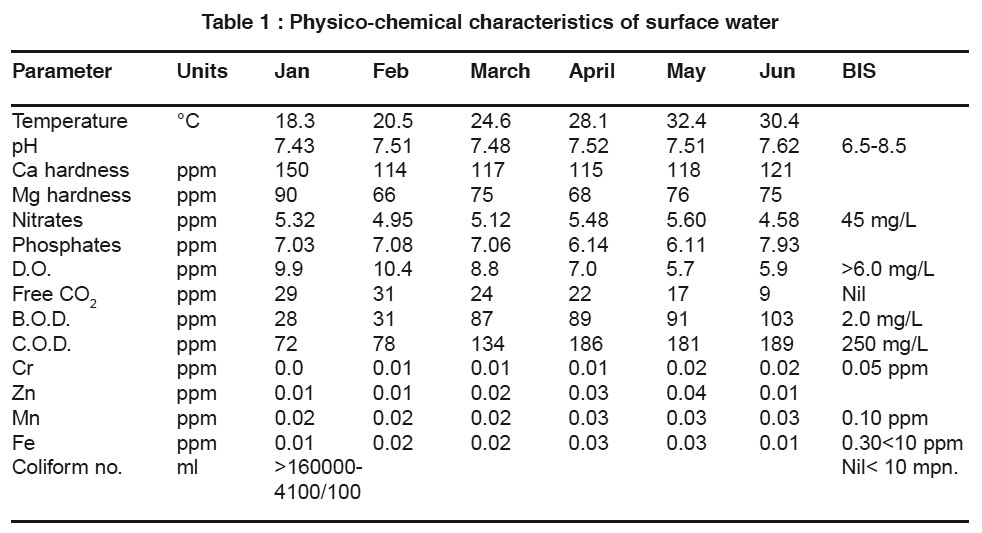Nutrient load on sewage fed Shahpura lake and possible eutrophication
Smita Joshi1 * , Pranjali Udhalikar1 and Pushpa M Rawtani1
1
Department of Chemistry,
S.N.G.G.P.G. College,
Shivagi Nagar,
Bhopal,
462 003
India
DOI: http://dx.doi.org/10.12944/CWE.3.2.18
Shahpura Lake is the third biggest lake of Bhopal City, and is also known as Mansarovar Reservoir. Shahpura lake was constructed in 1974-75 under Betwa Irrigation Project. Most of the western site of lake is covered with agricultural land. The lake mainly receive overflow of an oxidation plant (Near Mata Mandir) and sewage of Mata Mandir slum area, Sahapura residential, hillock area and Academy of Administration. Due to low value of dissolved oxygen (D.O.), and with significant amount of chloride, sulphate, sulphide, ammonia, B.O.D. and C.O.D., the lake environment is reducing. It is found that enrichment of water body by the nutrients like nitrates and phosphates is accompanied by over abundance of algal bloom, shore vegetation and sedimentation, thus leading to the extinction of the lake, that will lead the eutrophication of lake.
Copy the following to cite this article:
Joshi S, Udhalikar P, Rawtani P.M. Nutrient load on sewage fed Shahpura lake and possible eutrophication. Curr World Environ 2008;3(2):311-312 DOI:http://dx.doi.org/10.12944/CWE.3.2.18
Copy the following to cite this URL:
Joshi S, Udhalikar P, Rawtani P.M. Nutrient load on sewage fed Shahpura lake and possible eutrophication. Curr World Environ 2008;3(2):311-312. Available from:http://www.cwejournal.org?p=141/
Download article (pdf)
Citation Manager
Publish History
Select type of program for download
| Endnote EndNote format (Mac & Win) | |
| Reference Manager Ris format (Win only) | |
| Procite Ris format (Win only) | |
| Medlars Format | |
| RefWorks Format RefWorks format (Mac & Win) | |
| BibTex Format BibTex format (Mac & Win) |
Article Publishing History
| Received: | 2008-05-12 |
|---|---|
| Accepted: | 2008-08-17 |
Introduction
Water system includes rivers, lakes, oceans, and ground water etc. Everywhere water pollution occurs due to the presence of dissolved materials of inorganic and organic origin. Shahpura lake is a man made impoundment, which was constructed in 1974-75 under Betwa Irrigation Project located in southern reason of Bhopal City. The area under study receives domestic raw sewage from surrounding habitation. The lake has been fully covered with Eichhornia crassipes, which poses eventual threat to the existence of lake.
Plant nutrients (Phosphorus and Nitrogen) enter fresh and marine system and lead to or intensify eutrophication. The term ‘Eutrophication’ has been derived from Greek word which means “Well nourished”. It describes a condition of lakes and reservoirs including excess algal growth, which may eventually cause their destruction. Eutrophication is not a new phenomenon and is actually responsible for the formation of huge deposits of coal and peat. Monitoring of various physico – chemical parameters will help us to shed light on the chemical quality of surface water and bottom seiments of the Shahpura lake and to know the extent of pollution that has occurred due to urbanization and increased anthropogenic activities around the lake.
Material and Methods
For the present study surface water from the centre of Shahpura lake is collected. After collection the bottles were immediately transported to the lab to avoid any unpredictable changes in the physico – chemical characteristics. Water sample were analyzed as per the standard method (APHA 19th edition 1995). Biological samples were analyzed as per the procedure laid down in fresh water biology by Ward and Whipple.
pH recorder by pH meter, D.O. by Winkler method, B.O.D. by incubation method, C.O.D. by K2Cr2O7 reflux method, metals by atomic Absorption Spectrophotometer, Hardness by EDTA titration method. Alkalinity and different ions by titrimetric method. Coliform determind by drop count method enumeration of plankton isolated colonies with dark centre show presence of typical coliform and clear watering colonies show negative test for coliform. Picking isolated colony and incubated in Maconkey’s Broth tube and see for gas formation. Record the coliform in MPN.
 |
Table 1 : Physico-chemical characteristics of surface water Click here to view table |
Results and Discussion
Variations in physico – chemical parameters of surface water of Shahpura lake (in 2007) is shown in Table.
-
Lower and Nitrate indicate the phenomena of eutrophication. ( high concentration shows lake water is nutrient rich.
-
Higher BOD indicates organic pollutants present in DO value indicate the reducing environment of lake.
-
Analysis indicate, that the Shahpura lake water is hard (hard water is more productive).
-
High concentration of Sulphate excess.
-
Higher COD is also index of organic matter pollutant of lake.
-
The concentration of Cr is less. (the permissible limit for Cr (+6) set by USPH standard is 0.05 ppm.
-
Concentration of Zn++ and Mn++ were found to be low.
-
Concentration of Fe is found to be sufficiently less.
Conclusion
The higher productivity and lower species diversity clearly indicate that the lake water is nutrient rich. On the basis of observation recorded, Shahpuraa lake can be classified in eutrophic category.
References
-
Rolling Revision of WHO guidelines for drinking water quality (2004)
-
Mandal O.P., Bandana Singh B.K., T.N. and Sinha K.M.P. Monthly variation in Physico-Chemical characteristic of a wet land of North Bihar (India). Poll.Res.22(1), (2003), 139-142.
-
De, A.K., Environmental Chemistry, 4th edition, New Age International Publishers, New Delhi, (2002) 231-272.
-
Garg, Jaya and Garg, H.K. Water Quality management: strategies for conservation of Bhopal water. Env. Conservation J., 2(2&3), (2001), 101-104.
-
Agarwal, A.K., - The Limnology studies on “Nutrient Recycling of Shahpura lake: Ph.D. Thesis, Barkatullah University Bhopal. (1995).
-
APHA Standard methods for the examination of water and waste water. American Public Health.






